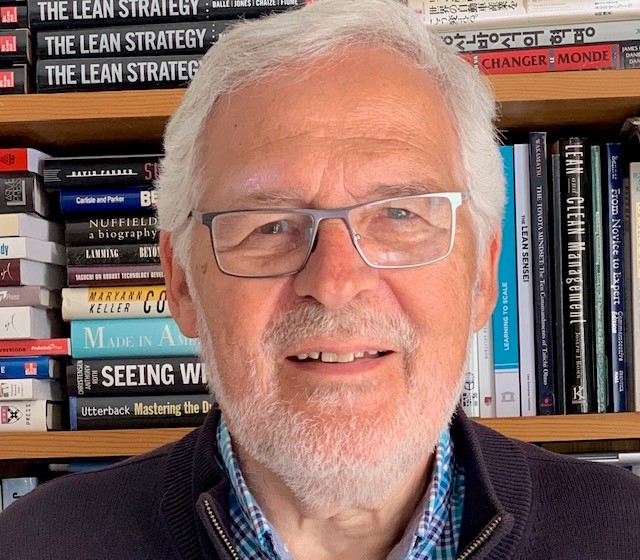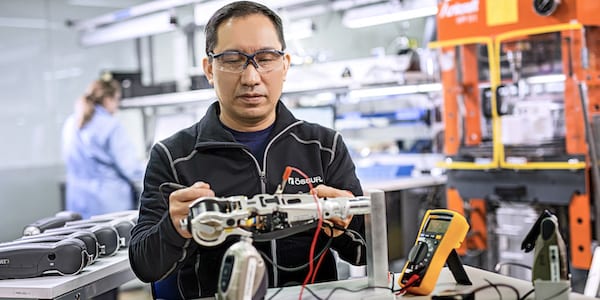
Embracing the kaizen spirit
FEATURE – When we emphasize systems and roles but fail to encourage and support kaizen, we cannot expect to tap into the full potential of Lean Thinking as a cognitive revolution.
Words: Michael Ballé, Daniel Jones, Jacques Chaize and Orest Fiume
Organizations have two fundamental challenges: first, to provide a useful service today and get paid for it (so as to continue to provide it) and, second, to provide a useful service and get paid for it tomorrow.
The mainstream solution to the first challenge has always been to go for volume through rigid processes in order to get paid today – and communicate on great plans for tomorrow without any clear idea on how to get there other than buying companies or purchasing new tech. Automation and Taylorism were the breakthrough ideas for rigid processes, driven by management by financial short-term objectives. Now, digital automation offers new opportunities to spread rigid processes beyond production to every function in the enterprise.
The downside of the mainstream approach has always been diminishing returns: increasing customer dissatisfaction, poor employee engagement, enormous financial waste on managerial mistakes, and fragility to catastrophes caused by skimping on maintenance, training, or by purchasing low-quality parts across the world at rock-bottom prices. This downside is often accepted as “schumpeterian” – older companies are replaced by newer ones as they rigidify and die. The waste to society is colossal, but the executives who drive this don’t really mind – they can always jump ship and find somewhere else to squeeze for short-term results.
The lean solution is radically different. Its aim is the long-term success of the organization, not just short-term shareholder value. As one old-time sensei once told me, Lean Thinking continuously balances success today with success tomorrow: without success today, you can’t have success tomorrow – quite obviously – but, more profoundly, without aiming at success tomorrow, you can’t really engage everyone in success today. You can only make them slave away in standardized processes.
As long-time Toyota veteran Tatsuhiko Yoshimura explains, lean shares with the mainstream solution the understanding that an organization is made of systems and tools on the one hand and roles and responsibilities on the other.

But where mainstream thinking assumes that systems and tools combined with roles and responsibilities are enough to guarantee performance (basically, when in doubt, add more systems and tools and reorganize roles and incentives to make sure people step up to their responsibilities, the principal-agent dominant theory), Lean Thinking adds a third, more mysterious ingredient – kaizen spirit.

Kaizen spirit makes the difference both today and tomorrow:
- Today: A culture of problem solving and small-step improvement oriented towards greater customer satisfaction (indeed, kaizen is all about getting value creation closer to customers) drives performance by enabling employees to contribute in three ways. One, doing their work more mindfully for customers. Two, turning improvement ideas into suggestions and being supported by their supervisors in implementing them. Three, participating in improvement workshops to make processes evolve and always seek better performance.
- Tomorrow: Understand what is changing in the market, both with customer preferences and new offers, to enable internal changes. These changes are enacted through teamwork, which means sharing with other departments and functions what changes are envisaged so that the problems caused by the changes are well understood by all and worked on systematically. Although apparently slower than simply purchasing a new function in or imposing changes through consultant-driven project management, this more careful approach to continuous change delivers far better results in teaching the organization to adapt continuously – and become good at it.
Three new books by Toyota veterans illustrate how this is done. With The Toyota Way of Dantotsu Radical Quality Improvement, Sadao Nomura shows us how a relentless drive to improve quality and reduce lead-times delivers volumes, in that order. In Welcome Problems, Find Success, Nate Furuta explains how problem finding and problem solving are the key skills that enable success at the strategic level by driving the capability to make strategic plans a reality. In Learning to Lead, Leading to Learn, Isao Yoshino with Katie Anderson describe how life-long learning is at the root of the mysterious “kaizen spirit” ingredient and the heart of Toyota’s long-term success through every market crisis imaginable.
All three books testify to the fact that there is no special “Toyota magic” – people do not “get” the kaizen spirit just because they join Toyota, and indeed many of the stories they recount are of areas where performance lags and morale is low precisely because executives focus on systems and roles at the expense of encouraging and supporting kaizen. Toyota culture, however, recognizes the importance of this kaizen spirit and has ways to teach and instil it, if not perfectly, at least systematically – often by resorting to “sensei”, experienced masters in fostering a kaizen culture.
But what if one is not part of the Toyota group of companies? The four of us have been asking ourselves this question since the mid-1990s. Dan as a co-founder of the lean movement and the evangelizer of lean in many new fields, from retail to healthcare; Orry as the Financial Director of one of the most successful lean turnarounds, Wiremold; Jacques as the CEO of his own company and the leader of its lean transformation; and Michael as a researcher of lean systems, starting with automotive suppliers in the 1990s and extending to a wide range of businesses and hospitals since the early 2000s.
Our conclusion is that in attempting to “lean” themselves, most companies fail precisely because they go the route of installing lean systems and creating lean roles – whether lean officers or value stream managers – and consistently ignore the third component, the “kaizen spirit,” mainly because their leaders do not even believe it exists. When we looked at successful lean transformations, we saw that lean leaders use the lean tools and systems to:
- Use Just-in-time across the supply network to focus the organization on the right problems, by discovering them first, and expressing them as key challenges that need to be resolved in order to “fix the base and grow the business.”
- Foster a culture of problem solving and “kaizen now!” so that anyone can participate in both problem solving and problem finding, and so that the hierarchy becomes a chain of help supporting competence rather than a chain of subordination enforcing compliance.
- Reinvest cost reduction gains from waste elimination in new products and new capabilities to continue delivering value to customers tomorrow as well as today, enabling kaizen at the company level.
How leaders do so, however, is where things get both interesting and tricky. We discovered that lean leaders do not simply delegate the implementation of lean systems and tools to people with new lean roles and responsibilities. They transform themselves before transforming their organizations. They understand that lean systems and lean people are worthless without the ability to leverage systems and roles: the competence to grasp and grow the lean spirit.
This lean strategy competence, we found, breaks down into four key practices: finding problems, facing problems, framing challenges, and forming solutions by involving everyone all the time:
- Find: Our minds spontaneously recognize usual problems and jump to usual solutions. More importantly, our minds’ default setting is applying a habitual, known solution to any new problem that presents itself. Problem finding is a discovery exercise that requires open-mindedness and looking beyond the immediate to understand and find consensus around what the problems truly are – and how they are new Lean leaders spend time at the workspace to observe work conditions, discuss issues with the people, and encourage them to find their voice: speak up on concerns, formulate problems and suggest improvements.
- Face: Collectives are very good at ignoring the elephant in the room and focusing on what they already know how to do. Indeed, our minds naturally reduce complex problems to the part that we know how to solve. Analyzing a problem means first quantifying it, and then breaking it down into manageable factors. Some of these factors are known, some are not. Facing problems means having the courage to face the unknown factors and look into things we currently don’t know how to do at all (as well as checking assumptions on “known” problems – nothing worse than thinking you know something that ain’t so). Problem facing is the act of tackling the part of the problem that seems intractable or impossibly out of your reach.
- Frame: No one solves large problems on their own. What makes humans so distinctive and so successful at realizing impossible things, such as building cathedrals, sending people into space, curing illnesses, or growing a global economy, is their ability to cooperate on common projects. To solve impossible problems, one must first learn to explain them in a simple way so that everyone can see their part in it and think about how to contribute. “Reducing carbon emissions to slow man-made global warming” is a clear frame for a complex problem. This doesn’t do justice to the complexity of the issue, but it gives a clear direction for everyone to get engaged in the issue and voluntarily participate to efforts to solving it. For instance, Furuta states, “A hoshin statement should clearly show all individuals your organization’s gaps between the target condition and the current condition. And it must provide everyone with room for their own interpretation of the statement to apply their specific responsibility and the means to establish measurements by which to gauge progress.”
- Form: New ideas rarely look pretty – they appear odd, awkward and unscalable. However, as people consider a new idea and try it in different ways – in lean terms, as they yokoten (copy and improve) – innovative ideas take shape and can deliver true organizational spanning innovations. Lean leaders learn to recognize unorthodox thinking, steer people to follow the PDCA process to refine their thinking, and then encourage them to pursue their ideas all the way to organizational change. Indeed, they run their organization by looking at what changes are happening out there (and how they are challenging the company), what changes everyone is carrying out, and how to better coordinate them so that the business keeps seeking the best quality and productivity while it changes. The organization is not transformed by an outside force, but truly formed from everyone’s insights and initiatives.

This way of thinking is a profound departure from the usual deployment approach taught in most business schools where the leader defines the situation out of hand, decides on the best option, drives its implementation through the organization, and then deals with the unavoidable fallout from decisions made in a meeting room and not from the ground up. Taylorist thinking in deploying processes through subordination and objectives might be effective in the short term, but it also rubs everyone the wrong way because it ignores local conditions and inevitably ends up in an inextricable mess. Roll-out looks attractive from headquarters, but we all know what happens next. Form, by contrast, is about getting early buy-in from engagement and achieving spill-over across the organization. For example, Kaoru Ishikawa’s original concept of TQM was the management of everyone’s voluntary participation in quality. Countermeasures are explored and discussed widely through the find, face and frame phases and then accepted rapidly as they grow from people’s own experience of the new ideas.
Lean Thinking is a cognitive revolution, not an organizational one. You can organize your company by value streams as much as you want, pay consultants for kaizen blitz programs, train your whole organization to lean concepts, but as long as you don’t pay the piper and invest in understanding the kaizen spirit yourself and how to sustain it among your staff, nothing will happen beyond short-term gains from low-hanging fruit. People need meaning. They need to align sense-making (making sense of what the leadership is trying to do) and meaning making (what does it mean for me) or, in Toyota’s terms, aligning personal fulfilment and corporate destiny. People need to join a program with a customer-based purpose, clear activities, participation in changes and a fair share of success. This starts with a radical change in leadership mindset – the true meaning of Lean Thinking.
THE AUTHORS




Read more


CASE STUDY - Össur is recognized as a leader in the fields of prosthetic, osteoarthritis and injury solutions, but how did lean management and a trial-and-error approach to improvement help it to stay competitive?


DOCUMENTARY – In PL’s first ever documentary, we share the story of a chain of car dealerships in Africa. Watch and learn how people development and lean leadership made for one of the best turnarounds you’ll ever encounter.


FEATURE - Develop your people if you want to develop a better (lean management) system in your business. This is the key message of this article, which looks at the role of management in an organization and in society.


FEATURE – There is a form of waste – complexity in raw and packaging materials – that adds costs to manufacturing without creating value, but it is often overlooked. The author explains what it is and how to banish it.

